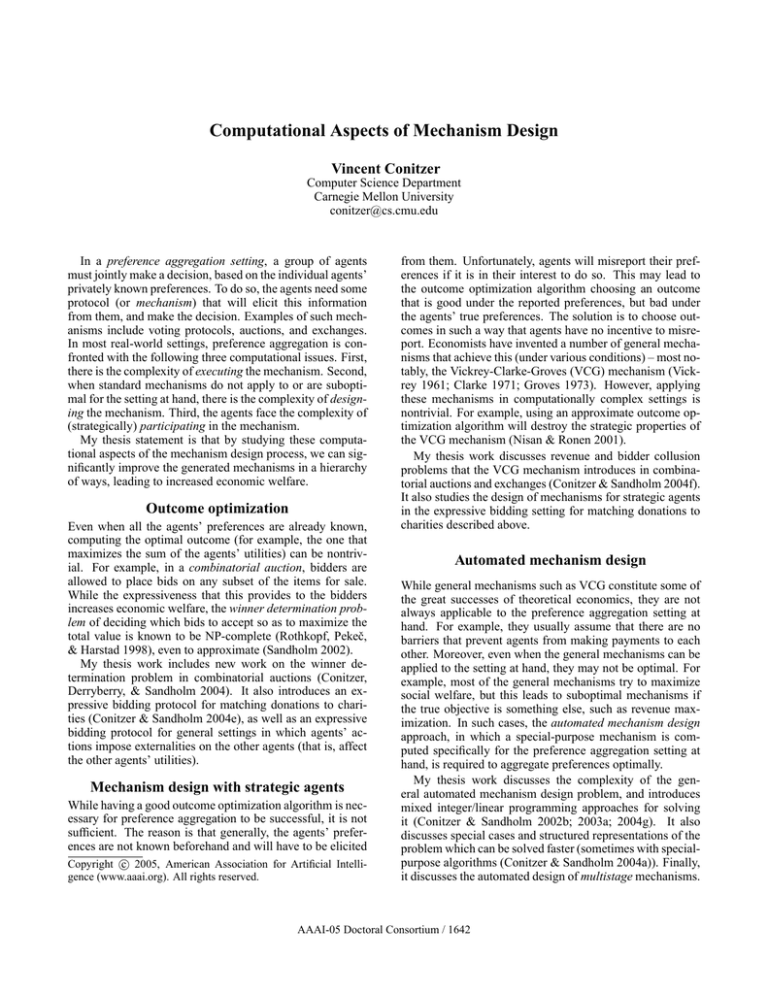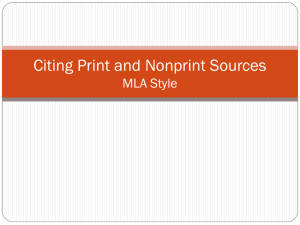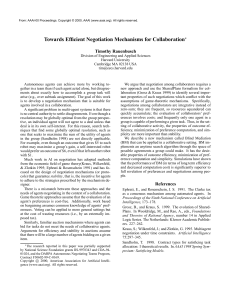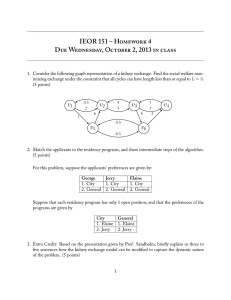
Computational Aspects of Mechanism Design
Vincent Conitzer
Computer Science Department
Carnegie Mellon University
conitzer@cs.cmu.edu
In a preference aggregation setting, a group of agents
must jointly make a decision, based on the individual agents’
privately known preferences. To do so, the agents need some
protocol (or mechanism) that will elicit this information
from them, and make the decision. Examples of such mechanisms include voting protocols, auctions, and exchanges.
In most real-world settings, preference aggregation is confronted with the following three computational issues. First,
there is the complexity of executing the mechanism. Second,
when standard mechanisms do not apply to or are suboptimal for the setting at hand, there is the complexity of designing the mechanism. Third, the agents face the complexity of
(strategically) participating in the mechanism.
My thesis statement is that by studying these computational aspects of the mechanism design process, we can significantly improve the generated mechanisms in a hierarchy
of ways, leading to increased economic welfare.
Outcome optimization
Even when all the agents’ preferences are already known,
computing the optimal outcome (for example, the one that
maximizes the sum of the agents’ utilities) can be nontrivial. For example, in a combinatorial auction, bidders are
allowed to place bids on any subset of the items for sale.
While the expressiveness that this provides to the bidders
increases economic welfare, the winner determination problem of deciding which bids to accept so as to maximize the
total value is known to be NP-complete (Rothkopf, Pekeč,
& Harstad 1998), even to approximate (Sandholm 2002).
My thesis work includes new work on the winner determination problem in combinatorial auctions (Conitzer,
Derryberry, & Sandholm 2004). It also introduces an expressive bidding protocol for matching donations to charities (Conitzer & Sandholm 2004e), as well as an expressive
bidding protocol for general settings in which agents’ actions impose externalities on the other agents (that is, affect
the other agents’ utilities).
Mechanism design with strategic agents
While having a good outcome optimization algorithm is necessary for preference aggregation to be successful, it is not
sufficient. The reason is that generally, the agents’ preferences are not known beforehand and will have to be elicited
c 2005, American Association for Artificial IntelliCopyright gence (www.aaai.org). All rights reserved.
from them. Unfortunately, agents will misreport their preferences if it is in their interest to do so. This may lead to
the outcome optimization algorithm choosing an outcome
that is good under the reported preferences, but bad under
the agents’ true preferences. The solution is to choose outcomes in such a way that agents have no incentive to misreport. Economists have invented a number of general mechanisms that achieve this (under various conditions) – most notably, the Vickrey-Clarke-Groves (VCG) mechanism (Vickrey 1961; Clarke 1971; Groves 1973). However, applying
these mechanisms in computationally complex settings is
nontrivial. For example, using an approximate outcome optimization algorithm will destroy the strategic properties of
the VCG mechanism (Nisan & Ronen 2001).
My thesis work discusses revenue and bidder collusion
problems that the VCG mechanism introduces in combinatorial auctions and exchanges (Conitzer & Sandholm 2004f).
It also studies the design of mechanisms for strategic agents
in the expressive bidding setting for matching donations to
charities described above.
Automated mechanism design
While general mechanisms such as VCG constitute some of
the great successes of theoretical economics, they are not
always applicable to the preference aggregation setting at
hand. For example, they usually assume that there are no
barriers that prevent agents from making payments to each
other. Moreover, even when the general mechanisms can be
applied to the setting at hand, they may not be optimal. For
example, most of the general mechanisms try to maximize
social welfare, but this leads to suboptimal mechanisms if
the true objective is something else, such as revenue maximization. In such cases, the automated mechanism design
approach, in which a special-purpose mechanism is computed specifically for the preference aggregation setting at
hand, is required to aggregate preferences optimally.
My thesis work discusses the complexity of the general automated mechanism design problem, and introduces
mixed integer/linear programming approaches for solving
it (Conitzer & Sandholm 2002b; 2003a; 2004g). It also
discusses special cases and structured representations of the
problem which can be solved faster (sometimes with specialpurpose algorithms (Conitzer & Sandholm 2004a)). Finally,
it discusses the automated design of multistage mechanisms.
AAAI-05 Doctoral Consortium / 1642
Designing mechanisms for
computationally bounded agents
The standard approach to designing mechanisms that perform well in the face of strategic agents is to assume that
agents will misreport their preferences whenever this is in
their best interest. This often leads to very cautious and
conservative mechanisms that never give the agents incentives to misreport their preferences (that is, they are truthful), but also do not generate much value. (Occasionally,
this approach even leads to an impossibility result that states
that no desirable mechanism exists, such as the GibbardSatterthwaite theorem in the context of voting (Gibbard
1973; Satterthwaite 1975).) However, in complex preference aggregation settings, it may actually be computationally too hard for agents to find a beneficial insincere report
of their preferences. An ideal mechanism design process
would exploit these computational weaknesses of the agents
to generate mechanisms which are better for all involved.
My thesis work shows that in some voting protocols,
it can be computationally hard to find a beneficial insincere vote (Conitzer & Sandholm 2002a; Conitzer, Lang,
& Sandholm 2003). It also introduces new voting protocols that are especially hard to manipulate with insincere
votes (Conitzer & Sandholm 2003f). Additionally, it exhibits settings in which there are insincere mechanisms that
always perform at least as well as truthful mechanisms, and
perform strictly better in the face of high computational
complexity (Conitzer & Sandholm 2004c). As an initial step
towards the general design of mechanisms for computationally bounded agents, my thesis work studies the complexity of basic solution concepts in game theory, such as Nash
equilibrium (Conitzer & Sandholm 2003e), (iterated) dominance (Conitzer & Sandholm 2005b), the core (Conitzer
& Sandholm 2003d), and the Shapley value (Conitzer &
Sandholm 2004d); as well as various topics on learning in
games (Conitzer & Sandholm 2003b; 2003c; 2004b).
Work to be completed
There are many important unresolved questions pertaining
to the individual topics discussed above. A more significant question, however, is how to combine the above approaches to mechanism design into a single unifying framework – one in which mechanisms are automatically designed
for the setting at hand, for bounded agents. There are technical reasons why this is not straightforward: it would require a more sophisticated approach to automated mechanism design and/or more sophisticated models of bounded
agents. Another important question that we continue to address is how to perform the actual elicitation of the agents’
preferences efficiently (Conitzer & Sandholm 2002c; Santi,
Conitzer, & Sandholm 2004; Conitzer & Sandholm 2005a).
References
Clarke, E. H. 1971. Multipart pricing of public goods. Public
Choice 11:17–33.
Conitzer, V., and Sandholm, T. 2002a. Complexity of manipulating elections with few candidates. AAAI, 314–319.
Conitzer, V., and Sandholm, T. 2002b. Complexity of mechanism
design. UAI, 103–110.
Conitzer, V., and Sandholm, T. 2002c. Vote elicitation: Complexity and strategy-proofness. AAAI, 392–397.
Conitzer, V., and Sandholm, T. 2003a. Automated mechanism
design: Complexity results stemming from the single-agent setting. Proceedings of the 5th International Conference on Electronic Commerce (ICEC-03), 17–24.
Conitzer, V., and Sandholm, T. 2003b. AWESOME: A general multiagent learning algorithm that converges in self-play and
learns a best response against stationary opponents. ICML, 83–
90.
Conitzer, V., and Sandholm, T. 2003c. BL-WoLF: A framework
for loss-bounded learnability in zero-sum games. ICML, 91–98.
Conitzer, V., and Sandholm, T. 2003d. Complexity of determining nonemptiness of the core. IJCAI, 613–618.
Conitzer, V., and Sandholm, T. 2003e. Complexity results about
Nash equilibria. IJCAI, 765–771.
Conitzer, V., and Sandholm, T. 2003f. Universal voting protocol
tweaks to make manipulation hard. IJCAI, 781–788.
Conitzer, V., and Sandholm, T. 2004a. An algorithm for automatically designing deterministic mechanisms without payments.
AAMAS, 128–135.
Conitzer, V., and Sandholm, T. 2004b. Communication complexity as a lower bound for learning in games. ICML, 185–192.
Conitzer, V., and Sandholm, T. 2004c. Computational criticisms
of the revelation principle. Brief announcement at the ACM Conference on Electronic Commerce (ACM-EC), 262–263.
Conitzer, V., and Sandholm, T. 2004d. Computing Shapley
values, manipulating value division schemes, and checking core
membership in multi-issue domains. AAAI, 219–225.
Conitzer, V., and Sandholm, T. 2004e. Expressive negotiation
over donations to charities. ACM-EC, 51–60.
Conitzer, V., and Sandholm, T. 2004f. Revenue failures and collusion in combinatorial auctions and exchanges with VCG payments. Brief announcement at ACM-EC, 266–267.
Conitzer, V., and Sandholm, T. 2004g. Self-interested automated mechanism design and implications for optimal combinatorial auctions. ACM-EC, 132–141.
Conitzer, V., and Sandholm, T. 2005a. Communication complexity of common voting rules. ACM-EC (to appear).
Conitzer, V., and Sandholm, T. 2005b. Complexity of (iterated)
dominance. ACM-EC (to appear).
Conitzer, V.; Derryberry, J.; and Sandholm, T. 2004. Combinatorial auctions with structured item graphs. AAAI, 212–218.
Conitzer, V.; Lang, J.; and Sandholm, T. 2003. How many candidates are needed to make elections hard to manipulate? Theoretical Aspects of Rationality and Knowledge (TARK), 201–214.
Gibbard, A. 1973. Manipulation of voting schemes. Econometrica 41:587–602.
Groves, T. 1973. Incentives in teams. Econometrica 41:617–631.
Nisan, N., and Ronen, A. 2001. Algorithmic mechanism design.
Games and Economic Behavior 35:166–196.
Rothkopf, M.; Pekeč, A.; and Harstad, R. 1998. Computationally manageable combinatorial auctions. Management Science
44(8):1131–1147.
Sandholm, T. 2002. Algorithm for optimal winner determination
in combinatorial auctions. Artificial Intelligence 135:1–54.
Santi, P.; Conitzer, V.; and Sandholm, T. 2004. Towards a characterization of polynomial preference elicitation with value queries
in combinatorial auctions. COLT, 1–16.
Satterthwaite, M. 1975. Strategy-proofness and Arrow’s conditions: existence and correspondence theorems for voting procedures and social welfare functions. Journal of Economic Theory
10:187–217.
Vickrey, W. 1961. Counterspeculation, auctions, and competitive
sealed tenders. Journal of Finance 16:8–37.
AAAI-05 Doctoral Consortium / 1643







